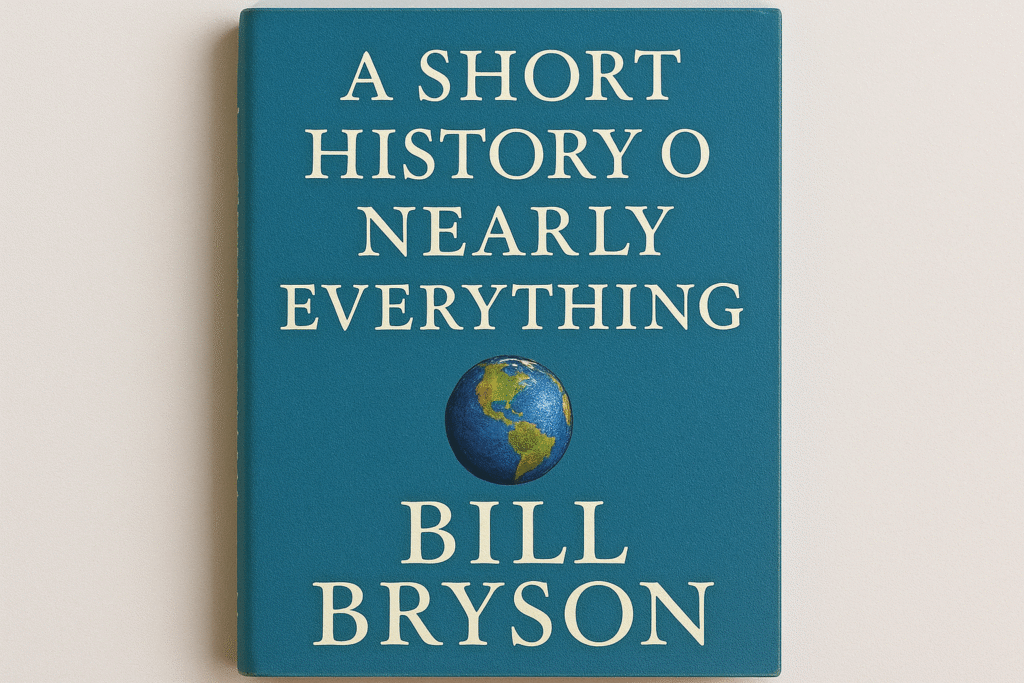<meta name='impact-site-verification' value='34369dc5-877c-4282-90a9-36f86721ccfa'>
5 Best History of Everything Books That Explain Our Universe
Understanding how we got here—from the Big Bang to modern civilization—requires grappling with an almost incomprehensible scope of time and complexity. Fortunately, several brilliant authors have tackled this monumental challenge, creating accessible books that weave together cosmology, biology, anthropology, and human history into compelling narratives about everything that exists.
These “history of everything” books serve as intellectual adventures, taking readers on journeys that span 13.8 billion years. They answer fundamental questions about our origins while revealing surprising connections between seemingly unrelated phenomena. Whether you’re curious about how stars form, why humans developed language, or what genetic research reveals about our ancestors, these five books offer different approaches to understanding the grand story of existence.
Each book brings unique strengths to this ambitious undertaking. Some focus on scientific discovery and natural processes, while others examine human development and cultural evolution. Together, they represent the best attempts to make sense of everything we know about our universe and our place within it.
A Short History of Nearly Everything

Bill Bryson’s masterpiece transforms complex scientific concepts into an entertaining exploration of how scientists discovered fundamental truths about our world. Rather than simply presenting facts, Bryson focuses on the human stories behind major scientific breakthroughs, revealing the personalities, rivalries, and accidents that shaped our understanding of the universe.
The book covers an extraordinary range of topics, from the formation of the universe to the development of life on Earth. Bryson excels at explaining why certain discoveries matter and how they fit into the larger picture of scientific knowledge. He has a particular talent for making abstract concepts concrete through clever analogies and surprising comparisons.
What sets this book apart is Bryson’s ability to convey both the wonder of scientific discovery and the often quirky nature of scientists themselves. He introduces readers to forgotten pioneers whose contributions were overlooked, as well as famous figures whose personalities were far more interesting than their textbook portraits suggest.
Bryson’s background as a travel writer serves him well in this scientific journey. His skill at observing details and finding humor in unexpected places makes potentially dry subjects engaging. The book succeeds because it never loses sight of the human element in scientific progress, showing how curiosity and persistence gradually revealed the secrets of existence.
→ Click here to get the book on Amazon
The History of Everything: A Graphic Novel

This innovative approach to cosmic history uses visual storytelling to make complex concepts accessible to readers who might find traditional science books overwhelming. The graphic novel format allows for creative representations of abstract ideas, using illustrations to clarify concepts that are difficult to grasp through text alone.
The book covers the same vast timeline as other “history of everything” works but employs different techniques to engage readers. Visual metaphors help explain quantum mechanics, evolutionary processes, and cosmic events. The artistic approach makes scientific concepts more memorable by providing visual anchors for complex information.
What makes this format particularly effective is its ability to show rather than just tell. Readers can see representations of atomic structures, evolutionary trees, and astronomical phenomena that would require extensive description in traditional books. The visual elements don’t simply illustrate the text—they become integral to understanding the concepts being presented.
The graphic novel approach also allows for creative storytelling techniques that wouldn’t work in conventional science writing. Characters can serve as guides through different eras, and visual transitions can show the progression of time and change in ways that pure text cannot achieve.
This book proves that serious scientific content doesn’t require a serious presentation. By embracing the possibilities of visual storytelling, it opens up the grand narrative of existence to readers who learn better through images and might be intimidated by dense scientific prose.
→ Click here to get the book on Amazon
The Dawn of Everything: A New History of Humanity

David Graeber and David Wengrow challenge conventional narratives about human social development in this groundbreaking reexamination of our species’ journey from hunter-gatherers to complex civilizations. The book argues that traditional stories about human progress—from simple to complex, from egalitarian to hierarchical—dramatically oversimplify the actual diversity of human social organization.
The authors present extensive archaeological and anthropological evidence showing that early humans experimented with many different forms of social organization. Some societies developed complex institutions without permanent hierarchy, while others created elaborate seasonal variations in their social structures. This evidence suggests that humans have always been conscious social experimenters rather than passive followers of evolutionary imperatives.
Their research reveals that many assumptions about “primitive” societies reflect modern prejudices rather than historical reality. They demonstrate that indigenous peoples often developed sophisticated political philosophies and social technologies that challenge Western assumptions about progress and civilization.
Graeber’s background as an anthropologist and activist, combined with Wengrow’s archaeological expertise, brings both theoretical sophistication and empirical rigor to their analysis. They draw on decades of research from multiple disciplines to build their case for a more complex understanding of human social development.
The book’s implications extend beyond academic debates about the past. By showing that humans have always had choices about how to organize their societies, the authors suggest that contemporary social arrangements are not inevitable results of human nature but contingent outcomes that could be different.
→ Click here to get the book on Amazon
A Short History of Nearly Everything: Special Illustrated Edition

This enhanced version of Bryson’s classic work adds hundreds of photographs, diagrams, and illustrations that complement and expand upon the original text. The visual elements help readers better understand scientific concepts while providing stunning examples of the phenomena Bryson describes.
The illustrations serve multiple purposes beyond simple decoration. Photographs of geological formations help readers visualize the time scales Bryson discusses, while diagrams clarify complex processes like plate tectonics and evolutionary development. Historical images of scientists and their equipment provide context for the human stories that drive the narrative.
What makes this edition particularly valuable is how the visual elements enhance rather than replace the text. Readers can see actual examples of fossils, crystals, and astronomical objects that would otherwise remain abstract concepts. The images create additional layers of meaning and help accommodate different learning styles.
The production quality of this edition reflects the publisher’s commitment to making science accessible and appealing. The careful selection and placement of images shows how visual design can support educational content without overwhelming it. Each illustration feels purposeful rather than gratuitous.
This version demonstrates how traditional scientific writing can be enhanced through thoughtful visual presentation. It bridges the gap between conventional books and more experimental formats, offering readers the best of both approaches to understanding our universe’s history.
→ Click here to get the book on Amazon
A Brief History of Everyone Who Ever Lived: The Human Story Retold Through Our Genes

Adam Rutherford uses genetic research to reconstruct human history, revealing surprising truths about our origins, migrations, and relationships. The book demonstrates how DNA analysis has revolutionized our understanding of human development, often overturning long-held assumptions about ancestry and cultural connections.
Rutherford excels at explaining how genetic techniques work and why their results matter for understanding human history. He shows how scientists can trace population movements, estimate when groups separated, and identify previously unknown connections between seemingly distant peoples. The genetic evidence often contradicts traditional historical narratives based on language, culture, or geography.
The book addresses controversial topics like race and intelligence with scientific rigor, explaining why genetic research has debunked many popular misconceptions about human differences. Rutherford carefully distinguishes between what the genetic evidence actually shows and what people sometimes claim it proves.
As a geneticist and science communicator, Rutherford brings both technical expertise and storytelling skill to this complex subject. His background allows him to explain cutting-edge research while avoiding the oversimplifications that sometimes plague popular science writing. He’s particularly effective at showing how genetic research connects to broader questions about human nature and social organization.
The book succeeds in making genetic analysis accessible to general readers while maintaining scientific accuracy. Rutherford demonstrates how this relatively new field is transforming our understanding of who we are and where we came from, adding crucial evidence to humanity’s ongoing attempt to understand itself.
→ Click here to get the book on Amazon
Choosing Your Journey Through Deep Time
These five books offer different pathways into the vast story of existence, each with distinct strengths and appeals. Bryson’s original work remains the most comprehensive introduction to scientific discovery, while the graphic novel format provides unique visual insights. Graeber and Wengrow challenge assumptions about human social development, the illustrated edition enhances scientific concepts through visual presentation, and Rutherford reveals what our genes tell us about human history.
Rather than competing with each other, these books complement different interests and learning styles. Readers seeking broad scientific literacy might start with Bryson, while those interested in human social development could begin with Graeber and Wengrow. Visual learners might prefer the graphic novel or illustrated editions, and those curious about genetics could dive into Rutherford’s genetic history.
The beauty of “history of everything” books lies in their ability to reveal connections across vast scales of time and space. They remind us that understanding our universe requires integrating insights from multiple disciplines and perspectives. Whether you’re drawn to cosmic history, human development, or genetic detective work, these books offer entry points into the grandest story ever told.

News host Brian Kilmeade has written several popular history books focusing on lesser-known episodes from America’s past. This collection brings together
Thanks for sharing superb informations. Your web site is so cool. I am impressed by the details that you have on this site. It reveals how nicely you perceive this subject. Bookmarked this web page, will come back for more articles. You, my pal, ROCK! I found simply the info I already searched all over the place and just couldn’t come across. What an ideal website.
An interesting discussion is worth comment. I think that you should write more on this topic, it might not be a taboo subject but generally people are not enough to speak on such topics. To the next. Cheers